Welcome back, and thanks for being here. I have two stories for you this week: a race report and a commentary.
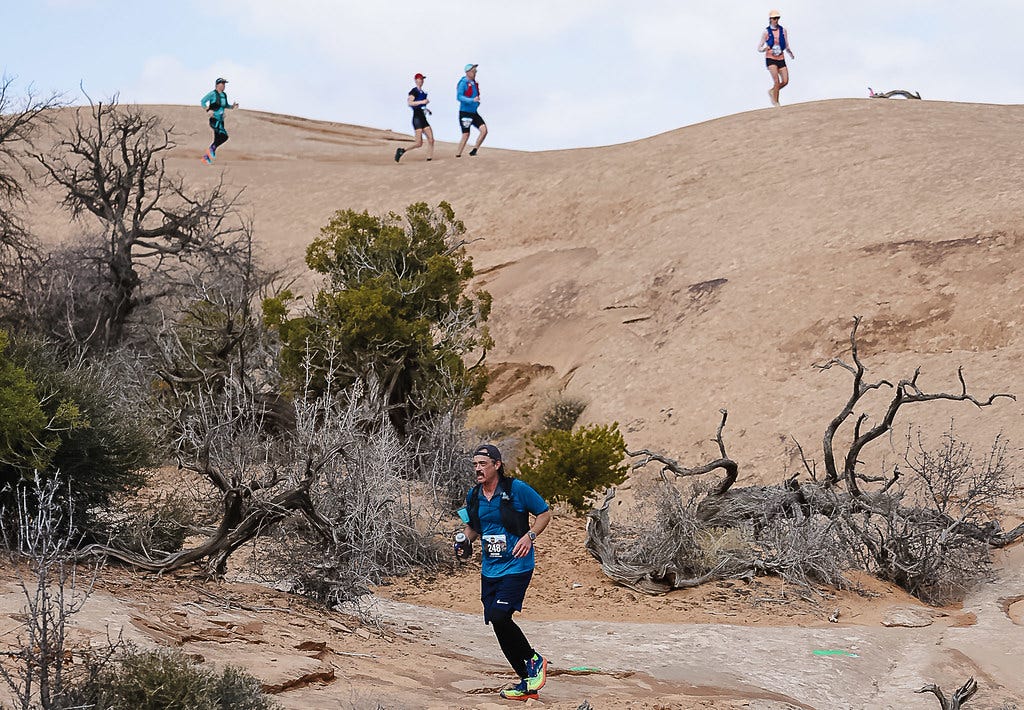
Moab Run the Rocks race review
I’m trying to recall the last time a race left me on a high rather than disappointed. A string of recent ultras, including Run Rabbit Run 100 last fall, felt more like coping and surviving than a confidence-building achievement. I have to go back a year to the Antelope Canyon 50 last March, or maybe to the Silverton Alpine/Kendall Mountain double in July, for feel-good memories.
I’m still on a high from last weekend’s Moab Run the Rocks 3-Day, a stage race with approximately 51 miles broken into three days: 12.5 miles Friday, almost 25 Saturday, and around 13.5 Sunday. The event also offers a “half pint” division with shorter daily mileage totaling 33 for the three days.
I signed up for the Moab 3-Day because I need the training for April 20’s Leona Divide 100K, and because the awesome Erica Moore (profiled here) encouraged me. We’ve known each other long distance for over a decade, since we connected over ultras and realized we went to the same high school, so this would be a chance to finally meet in person. We ended up hanging out and carpooling in the mornings.
Moab is a prime running (and hiking and biking) destination in spring and fall, before summer heat bakes the desert. The sculpture-like red-rock formations set against desert vistas never fail to dazzle, especially when seen in slanted early-morning light that saturates the hues.
I’ve experienced Mad Moose Events’ ultras in Moab several times and didn’t really know what to expect from this event put on by the TransRockies Race Series, best known for their Colorado six-day, 120-mile stage race in August. I never wanted to do their TransRockies 6-Day because Pepsi used to be their sponsor. I mean, Pepsi? Plus, I’m a stage-race purist of sorts, preferring a stage race that’s self-supported and minimalist, like the Grand to Grand Ultra, not a weeklong moveable feast and party, as TransRockies seems to be. (To their credit, the race organizers dropped Pepsi nearly a decade ago, and now the sponsors are more runner-friendly and healthier.)
I feared their Moab spinoff, started in 2023, would be overly crowded and commercialized, since every email blast tried to get us to sign up for their sponsors’ stuff and advertised all the ancillary events around the race, such as happy hours. But those fears were unfounded.
Bravo to the race organizers for a really well-run event with interesting routes. All three days take place on trails and dirt roads north of Moab in the Dead Horse/Gemini Bridges/Bar M areas (the long stage overlaps a lot with Mad Moose’s Dead Horse Ultra). With some 210 runners in the “full pint” division and some 275 in the “half pint,” with different start times for the two divisions, it didn’t feel too crowded on the trail.
The parking lots, however, were crowded. My suggestion to the race director: encourage carpooling, and set up a pickup area where runners can catch a ride.
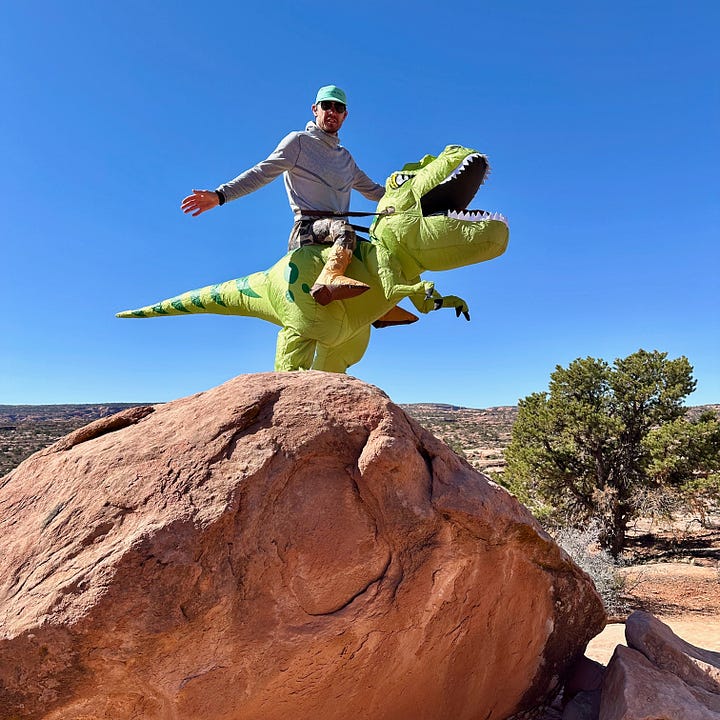
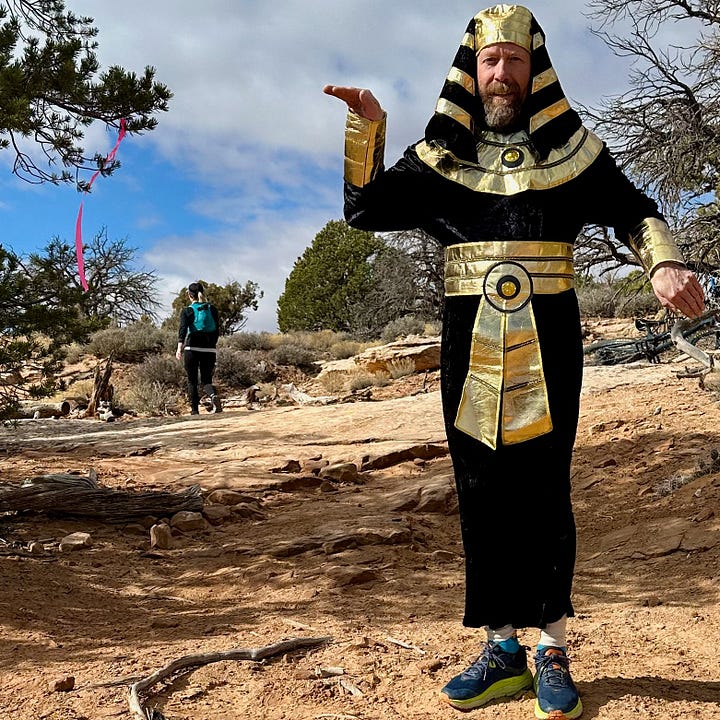
Costumed volunteers position themselves at every key juncture to direct runners, so it was easy to stay on course—although the slickrock portions always require close attention to the painted marks on the rock and the course-marking ribbons. The three days’ routes feature a lot of slickrock, which challenged me and probably everyone else too.

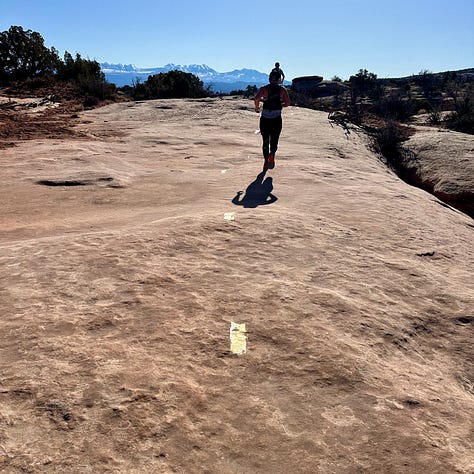
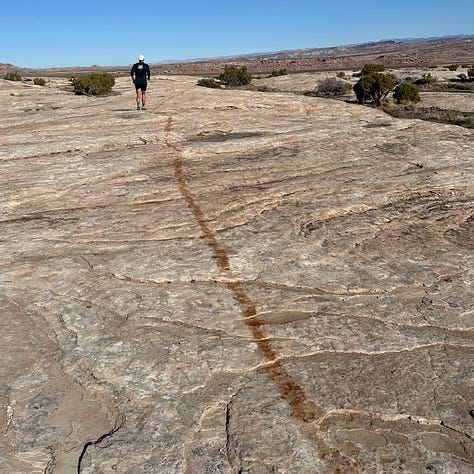
The slickrock surface undulates, slopes, and features all kinds of subtle hard-to-see textures like bumps and cracks, so it’s nearly impossible to establish a rhythm for running. The slickrock route—painted with lines or small marks for mountain bikers and hikers to follow—twists and turns like a maze. Every slickrock stretch feels mentally exhausting, as well as slow going, because it requires such a high level of concentration.
While I got passed by a lot of runners on the slickrock, I made up time and ran well on the technical rocky single track and the smoother dirt roads. The rock-strewn single track combined with the swaths of slickrock forced me to work on agility, and I feel I improved quick-footed moves over the three days.
Best of all, I stayed positive. I did not fall into the comparison trap, judging my performance on how I placed relative to others. An old mantra, “run your own race, go your own pace,” helped me do my own thing as best I could.

I set a few goals and hit all of them. Notice how they’re process oriented—concerned with how to execute the race—and these process goals led to a good outcome.
Average a sub-12 minute pace. Given the amount of hiking needed on the extra-technical parts and sharp hills, this average pace felt challenging. I logged many miles with hiking at a greater-than-13-minute/mile pace, so I had to push to make up time on the more runnable stretches. This became a motivating game that held my focus. My average per-mile paces for the three stages turned out to be: 10:50, 11:48, and 11:48 again.
Don’t fall. I really did not want to trip and eat it on the rocks. This made me mindful about lifting up my feet and not catching a toe, and to stay focused rather than space out. I’m so happy I never stumbled.
Be a closer. By that I mean, take care of myself along the way each day, and pace well, so that I still had gas in the tank in the final miles to finish strong and chase down others.
My time for the three days totaled 9 hours, 49 minutes, and I placed 72nd out of 200+ finishers (results). I was only fourth in the women’s 50+ age category because there were three 50+ women waaaayyyy faster than I. Check out the close competition and super times between the top two 50+ women. How awesome is that? It’s more proof that over-50 runners are legit competitors and deserve recognition.
To that end, I really appreciate how the TransRockies race organization spotlights the 50+ “grandmaster” category for men and women with its own division and own top-level prizes. The 40-something “masters” get lumped together with the younger age categories. This is the first time I’ve seen a race do away with typical decade-by-decade age groups and have only two categories: Under 50 and 50+. It makes us over-50 runners feel recognized and appreciated.
The long weekend stoked my motivation to train for my “A” goal this September, the weeklong self-supported 170-mile Grand to Grand Ultra stage race (registration is still open for it, and you still have time to train, if you’re interested!). Last weekend reminded me that I love stage racing—the routine of racing in the morning, recovering in the afternoon, with each day providing a fresh start and new opportunity to make the most of that stage.
I’ll end with these pics of three women I enjoyed talking to this weekend: Patty Nooney, who’s in this subscriber group and who did the inaugural Grand to Grand Ultra with me back in 2012; Maggie Guterl, who’s getting back to running after injury and ramping up for Hardrock; and Erica Moore, who’s following up this three-day event with the Canebrake 200-miler in Georgia in two weeks (!). Plus, a happy finish-line photo of me.
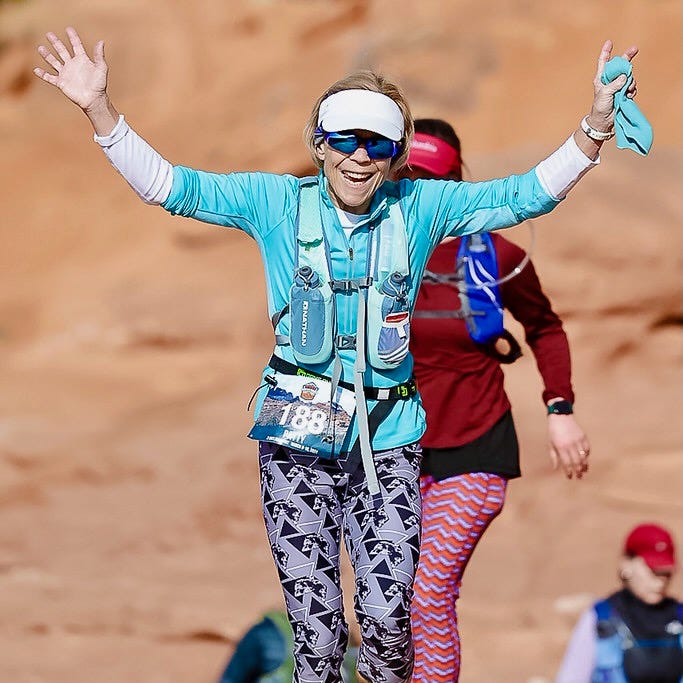

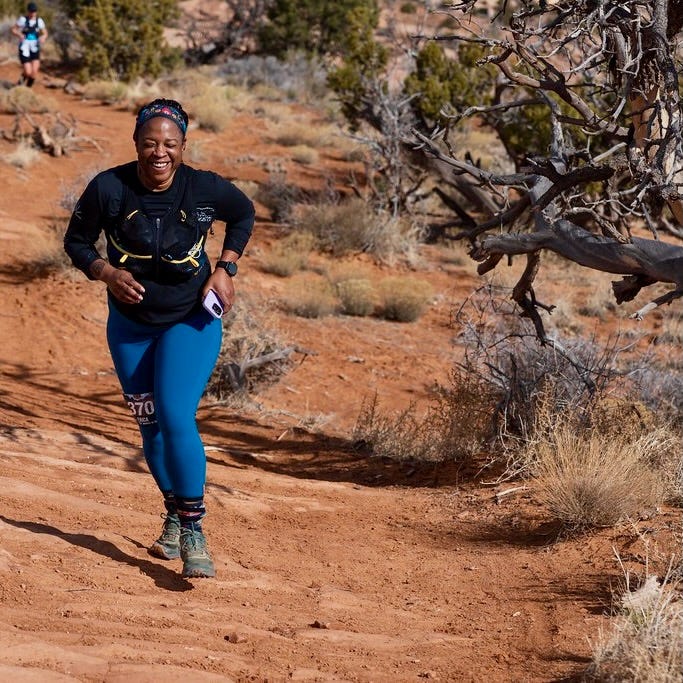
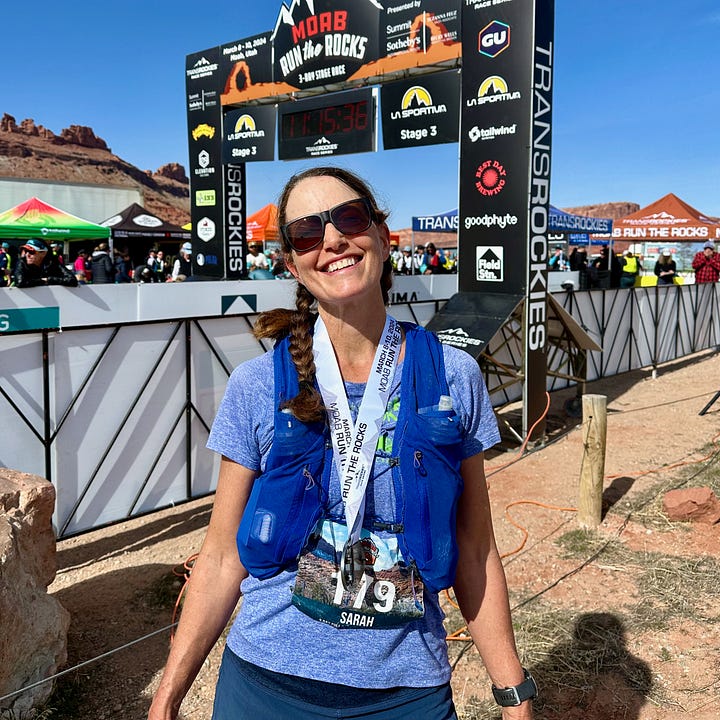
What’s my problem with Lululemon?
The whole time I was in Moab and the days following, I kept checking my phone for updates from the Lululemon Further six-day event, in which a team of 10 women ran as much and as far as they could around the clock, fully supported by an infrastructure set up by the brand while taking part in a big medical research project to enhance female-specific sports science. I became totally hooked following four of them in particular—Camille Herron, Leah Yingling, Devon Yanko, and Mirna Valeria—since I’ve followed these four runners for quite some time. Plus, it was interesting to learn about the other six.
There’s so much I could unpack and say about this event. What gets me, and what I’m honestly trying to work through by writing this, are the conflicted feelings it stirred up in me. Why do I feel so strongly and so mixed about it?
On the one hand, I’m blown away by these women and have been rooting for them. It’s mind-bending that Camille broke so many world records by getting to 560 miles, that Leah hit 400, that Devon surpassed 300 with all she faces health-wise (check out her Substack); and that Mirna, a plus-sized runner and advocate for large-body acceptance and diversity, logged over 140 miles for the six days. I’m sitting here struggling to get my weekly mileage totals over 50. I’ve run 100+ miles during 24-hour ultras on a loop course, and I’d lose my shit if I had to repeat that same loop for another five days.
I have mad respect for each of them.
I also applaud that they were given the support and time to do this—to fully, single-mindedly test themselves. The Further event became a female-ultra-endurance version of Nike’s Breaking2 project or Hoka's Carbon X project, taken to another level, and that’s super cool.
These women worked together as a team supporting each other, loving each other, and making each other stronger. They went further together than they could if they were pushing themselves solo.
So why does the love-fest, female-first feel of Further not entirely sit well with me?
My critical reaction has nothing to do with those 10 women. I don’t want anything that follows to be interpreted as diminishing their superlative physical and mental accomplishments.
It has to do with Lululemon the brand, and the choices the organizers made.
The event, which took place on a 2.55-mile route set up around Lake Cahuilla near Palm Desert in Southern California, played out on social media like a reality show as much as an athletic contest. Lululemon built a team of international women, from different athletic and cultural backgrounds, and made each a celebrity. Every runner came with a compelling back story and personal goals. It’s an undeniably diverse, accomplished, and interesting group of women.
But couldn’t they have expanded the team at least a little bit to have better representation, both for role modeling and for scientific research?
Lululemon chose a team that excludes two fundamental aspects of womanhood that many women struggle and need support with: mothering and aging. As far as I could tell, the six-day event featured zero celebration, or even mention, of motherhood. It also ignored any over-50 post-menopausal athletes.
Nine of the 10 women are childless, and I had to dig to discover that Mirna has a college-aged son, since she rarely publicly mentions or pictures being a mother. The event’s missed opportunity to portray mothers as endurance athletes makes me both sad and angry.
The brand—which set up special dressing and resting rooms for each athlete and her crew—could have set up a childcare area and shown dads or partners shouldering the parenting responsibilities for the week. If the kids stayed back home for school, then the portrayals could have shown how the moms and their families were supported in managing that separation. Wouldn’t it have been great to see a female athlete pushing her limits with a support group managing the care of her young kids so she doesn’t feel guilty or torn about prioritizing her sport?
Instead, the child-free event implicitly reinforced the message that to reach their full potential athletically in adulthood, women have to defer motherhood or choose not to have children.
The event also ignored women over age 50, even though we make up a significant part of the ultrarunning community. (The 10 participants range in age from 27 to 48. Half are in their 30s; Devon is 41, Camille is 42, Yoon Young Kang is 44, and Mirna is the oldest at 48.) I can think of several speedy, strong 50- and 60-something female runners who would’ve made a great addition to this team and its research.
This event could have been an opportunity to study post-menopause physiology in athletic women. Finally, women are talking about menopause and how best to manage its side effects on muscle mass, bone density, joint health, and sleep. We’re showing that even if we slow down after 50, we still have athletic goals and can be legit competitors. But Lululemon and its medical-research team seem uninterested in this age demographic, even though there’s a need for research on how menopause and hormone therapy affect athletic performance.
By choosing a young-looking team, Lululemon implicitly reinforced the message that when you reach a certain age and stop menstruating, you lose relevance. You’re an over-the-hill recreationalist, not a serious athlete. Gray hair and wrinkles don’t sell.
Even if Lululemon had filled my wish and built a team that spotlighted mothers and older runners, I’d still be reluctant to support the brand and wear its products because of its history.
This is not an authentic running brand developed by runners (like rabbit, for example). This is the premier pricey athleisure company that became insanely popular, starting around the mid-2000s, as a status symbol for affluence and exclusivity, favored by women more for yoga and barre studio workouts than for anything having to do with running and trails. Now it’s trying to gain prominence in the women’s running market because it’s a growing market, especially the trail-running segment.
It’s also trying to distance itself from its racist, fat-phobic founder’s legacy. (Read here about Chip Wilson’s string of outrageous remarks, which range from anti-Asian to fat-shaming to slamming diversity. He stepped down as CEO in 2013 but still holds the majority of the company’s shares.)
I can’t help view the Further event through the lens of the company’s past, and thus I see it as a massively well-choreographed marketing campaign designed to sell product and promote its image above all else, undercutting the event’s important aims of record-breaking performances, sports science research, and women-specific product innovation.
I don’t think a true running brand would’ve done a group photo shoot of their athletes the way Lululemon did, for example. It bothered me that the brand introduced the 10 women through a photo shoot staged indoors instead of outdoors, all of them looking strong and determined but also heavily stylized as models. The underlying message: You gotta get dressed up and look good to go for a run.
Using the Further event, Lululemon introduced its specially designed running apparel line and shoes. The product has functionality—thanks to the women athletes’ input—that seems genuinely useful for ultrarunning.
But the brand chose a look that is soft and blends in rather than being bold. The color combination features coral pinkish and orange hues, light brownish-tan sepia tones, a touch of pink as an accent, and patterns that have groovy swirls and shapes that hint at botanical or tropical. The palette is neutral, modern, yet feminine, kind of like throw pillows from Ikea.
Lululemon’s Further project was a life-changing and empowering experience for the team of 10 women, no question about that. It also likely will inspire countless viewers of varying backgrounds, abilities, and sizes to run. Maybe we’ll see a surge of interest in backyard-ultra type events from runners wanting to test themselves by running nearly nonstop in a loop for six days straight. That’s a trend I’d like to see.
I’m truly impressed by all 10 of the women and congratulate them for going after their furthest stretch goals.
Will the research on a small sample size make a meaningful contribution to women’s sports science? I hope so, but I honestly don’t know; I just know the event ignored female athletes who are mothers and who are post-menopause.
Will it prompt other brands to better support their sponsored female athletes? Jury’s out.
Will it make Lululemon’s Further running apparel line and shoes a hot seller? For sure.
For “further” reading: The Further event kicked off on International Women’s Day. This Women’s Running article, which doesn’t mention Lululemon, does an excellent job capturing my feelings on how International Women’s Day has been hijacked by marketing tie-ins. The headline and subhead convey the main point (but I hope you’ll read the article, because it’s so good): “This Women’s Day: Enough With The Hashtags—How social media and marketing turned empowerment into a hashtag that substitutes awareness for meaningful action, consumption as activism.”







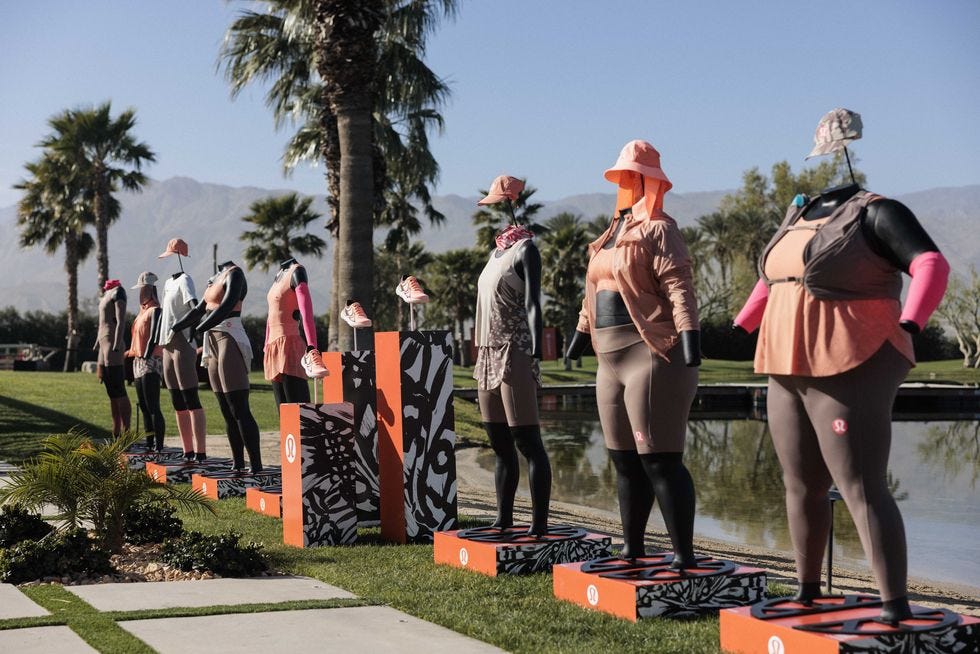
Honestly, I’m not all that bothered by the FURTHER event. Of course it was a marketing event put on by a company whose has a less than stellar track record. But it was also an event designed with heavy influence by Camille and the other athletes. The event itself was probably designed as a requirement of Camille signing with them (but I haven’t asked her personally and she might not be able to say publicly). It was also an unprecedented opportunity that the brand provided all ten athletes involved. One that any athlete, pro or newb, would be jealous to be involved in. (How much of your dislike is that you weren’t involved in any capacity? Not judging, just something to think about for a moment.) It was absolutely incredible to see not-Nike put scientific and monetary resources into running in a discipline that is not Olympic bound. I can’t wait for the data behind this project to come out.
Even with that input from the athletes, it was first and foremost a marketing event. Just as pro athletes are first and foremost marketing tools. We can argue if that needs to be changed elsewhere, but the point is that this insanely amazing athletic event is also meant to provide a huge ROI for the brand. Lululemon picked the women, designed the clothing, and marketed the event to match the brands target demographic in order to sell more clothes to the people who buy/are likely to the most already from Lululemon. As much as we want them to be, a brand can’t be all things to all people, and Lululemon knows their lane. They stayed in it. Trendy, high end athletic gear, that’s stylish enough to wear to the cafe after one’s run or, not to be too shocking, to wear to the cafe without having even run at all. It wasn’t going to be bold. It was going to be trendy, look good on camera, and the marketing shots for said clothing was going to make the women look like models… I’m just happy the clothing was functional (more than many brands can say).
Would it have been cool for this one of a kind event to have included the demographics you mention (or my own)? Absolutely. Am I in anyway mad that Lululemon diversified in a way that was incredibly inclusive (even without comparing it to the failed diversity efforts of really any brand’s trail running team it was a huge step), allowed them to focus on their target demographic, and allowed the medical researchers to collect data on the demo they wanted, while giving a once in a lifetime opportunity to ten incredible women, and they didn’t get it 100%. Absolutely not.
As easy as it is to criticize Lululemon, this event was never going to be all things to all people. Nor should it have had to be.
I think it’s on us to lobby for “the next FURTHER”. To have top, bankable talent, influencers (of any kind not just SM), and researchers approach $brand and say these demos were missed at the event. These are key demographics who spend money at your brand but who were overlooked when Lululemon did their event. Let’s do something to target them. ROI talks. That’ll get someone interested in talking and funding the next project in whatever form it takes. If no brand wants to take part then researchers and athletes can collaborate to get grants to support research on older athletes, and maybe seek sponsorship for the project once the research projects have been put in place. It’s hard work but ground up and is likely the only way something like it will get done. Talk to Megan Roche or the handful of other folks doing research on female athletes. (Roche was involved in FURTHER and maybe has thoughts on how to achieve the next one.) It’s not a big community.
As for FURTHER, it was amazing to watch. I know it inspired a lot of people. Even tons in the demos they overlooked, as well as non-runners, men, and all sorts of others. Incredible achievements all around, by all involved, including the support, research, and marketing staff too. At the end of the day it’s also a big commercial for a high end athleisure clothing brand. It can be both without having one detract from the other.
(I write all this not owning anything Lululemon, nor having strong opinions good or bad about the company, while also knowing the founder’s problematic views yet also knowing he hasn’t been involved in any company governance in more than ten years. It’s just another brand.)
Sorry for the essay, it was written out on my phone and that usually makes it 10x longer than it needs to be.
Your comments regarding not including many mothers is interesting to me. I didn’t notice. But I’m also not a mother. I would have liked to hear more about each persons story, the idea of using influencers instead of having a live stream or content from the organisers really annoyed me, especially at the start when there was just the tracker page.
As a child free woman, I find the mother athlete a bit of a trope that the media like to throw out there. I find it really frustrating, like they haven’t done any research and so the line is usually their performance is even more impressive “because they’re a mother”. Have you noticed that? It’s kind of insulting. No one mentions how many kids elite men have!
And why are they bragging about all their product innovations if we can’t buy them?